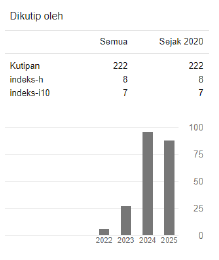Trends in the Use of Artificial Intelligence (AI) in Education: A Systematic Literature Review
 https://doi.org/10.54012/ijcer.v3i3.624
https://doi.org/10.54012/ijcer.v3i3.624
 Abstract views: 173
Abstract views: 173
 PDF downloads: 139
PDF downloads: 139
Keywords:
Artificial Intelligence, Systematic Literature Review, Adaptive Learning, Educational TechnologyAbstract
This study aimed to provide a systematic review of the trends in AI utilisation in education over the past decade (2015–2025). The Systematic Literature Review (SLR) method was employed following the PRISMA protocol, with data sources drawn from four major databases: IEEE Xplore, Scopus, Web of Science, and Google Scholar. The total number of selected and analysed articles offered in-depth insights into various forms of AI implementation, such as intelligent tutoring systems, adaptive learning, educational chatbots, automated assessment, and learning analytics. The findings of the review indicated that AI significantly contributed to personalised learning, educational management efficiency, and early detection of potential academic failure. However, notable challenges also emerged, particularly concerning ethics, data privacy, and algorithmic bias. In addition, technical and social barriers such as the digital divide and resistance from educators continued to hinder the equitable adoption of AI. This review concluded that strategic and ethical approaches were required in the development and implementation of AI in order to ensure greater inclusivity and sustainability. These findings were expected to serve as a foundation for educational policy and future research directions.
Downloads
References
R. S. Michalski, J. G. Carbonell, dan T. M. Mitchell, Machine Learning: An Artificial Intelligence Approach. Berlin: Springer, 2013.
W. Holmes, M. Bialik, dan C. Fadel, Artificial Intelligence in Education: Promises and Implications for Teaching and Learning. Boston: Center for Curriculum Redesign, 2019.
H. A. Keane dan M. D. Keane, “AI applications in education: Current use and future directions,” International Journal of Educational Technology in Higher Education, vol. 17, no. 1, pp. 1–15, 2020.
B. Woolf, Building Intelligent Interactive Tutors: Student-Centered Strategies for Revolutionizing E-learning. Burlington, MA: Morgan Kaufmann, 2009.
Z. Pardos dan N. Heffernan, “Navigating the parameter space of Bayesian Knowledge Tracing models: Visualizations of the convergence of the Expectation Maximization algorithm,” Educational Data Mining, vol. 1, no. 1, pp. 161–170, 2010.
A. Burrows, D. Moore, dan J. Wood, “Automatic essay scoring using machine learning,” Journal of Educational Computing Research, vol. 57, no. 1, pp. 1–26, 2019.
S. Ifenthaler dan D. Yau, “Utilizing learning analytics to support study success in higher education: A systematic review,” Educational Technology Research and Development, vol. 68, pp. 1961–1990, 2020.
S. Daniel, “Education and the COVID-19 pandemic,” Prospects, vol. 49, pp. 91–96, 2020.
R. Ferguson, “Learning analytics: Drivers, developments and challenges,” International Journal of Technology Enhanced Learning, vol. 4, no. 5/6, pp. 304–317, 2012.
A. Slade dan P. Prinsloo, “Learning analytics: Ethical issues and dilemmas,” American Behavioral Scientist, vol. 57, no. 10, pp. 1510–1529, 2013.
B. D. Mittelstadt et al., “The ethics of algorithms: Mapping the debate,” Big Data & Society, vol. 3, no. 2, pp. 1–21, 2016.
J. Holmes, M. Boardman, dan M. McLean, “Teachers’ perspectives on artificial intelligence in education: A qualitative study,” British Journal of Educational Technology, vol. 54, no. 1, pp. 1–15, 2023.
S. Selwyn, “Should robots replace teachers? AI and the future of education,” Polity Press, 2019.
H. Chen et al., “A systematic review of AI in education: Applications and challenges,” Computers & Education: Artificial Intelligence, vol. 3, pp. 1–12, 2022.
M. Zawacki-Richter, V. I. Marín, M. Bond, dan F. Gouverneur, “Systematic review of research on artificial intelligence applications in higher education – where are the educators?” International Journal of Educational Technology in Higher Education, vol. 16, no. 1, pp. 1–27, 2019.
K. A. Holmes dan S. M. Tuin, “Reviewing artificial intelligence applications in K-12 education,” Computers in Human Behavior Reports, vol. 7, 100234, 2022.
D. Moher et al., “Preferred reporting items for systematic reviews and meta-analyses: The PRISMA statement,” PLoS Medicine, vol. 6, no. 7, e1000097, 2009.
J. Gough, G. Oliver, dan J. Thomas, An Introduction to Systematic Reviews, 2nd ed. London: Sage Publications, 2017.
PRISMA Group, “Transparent reporting of systematic reviews and meta-analyses,” [Online]. Tersedia: https://www.prisma-statement.org. [Diakses: Apr. 15, 2025].
J. Higgins et al., Cochrane Handbook for Systematic Reviews of Interventions, version 6.3. Cochrane, 2022.
N. Booth, A. Papaioannou, dan G. Sutton, Systematic Approaches to a Successful Literature Review, 2nd ed. London: Sage, 2016.
B. Kitchenham, “Procedures for performing systematic reviews,” Keele University, Technical Report TR/SE-0401, 2004.
P. Petticrew dan H. Roberts, Systematic Reviews in the Social Sciences: A Practical Guide. Oxford: Blackwell Publishing, 2006.
D. Gough, S. Oliver, dan J. Thomas, “Clarifying differences between review designs and methods,” Systematic Reviews, vol. 1, no. 28, pp. 1–9, 2012.
D. Tricco et al., “A scoping review on the conduct and reporting of scoping reviews,” BMC Medical Research Methodology, vol. 16, no. 15, pp. 1–10, 2016.
V. Braun dan V. Clarke, “Using thematic analysis in psychology,” Qualitative Research in Psychology, vol. 3, no. 2, pp. 77–101, 2006.
H. M. Ifenthaler dan D. Yau, “The impact of AI and learning analytics on future learning environments,” Educational Technology & Society, vol. 24, no. 2, pp. 1–12, 2021.
American Psychological Association, Publication Manual of the American Psychological Association, 7th ed. Washington, DC: APA, 2020.
Downloads
Published
How to Cite
Issue
Section
License
Copyright (c) 2025 Sigit Apriyanto, Adelina Anum

This work is licensed under a Creative Commons Attribution-ShareAlike 4.0 International License.









